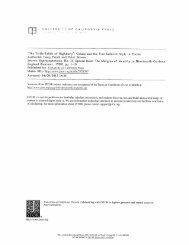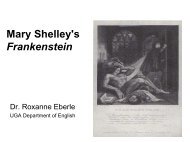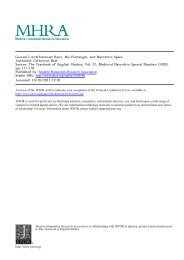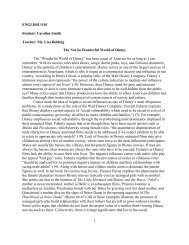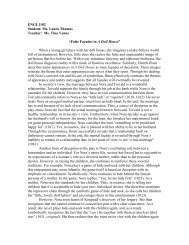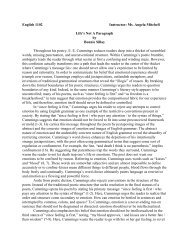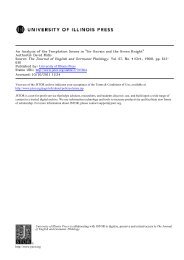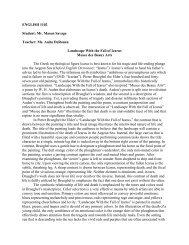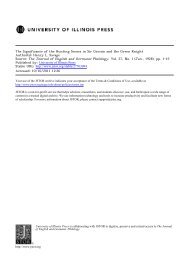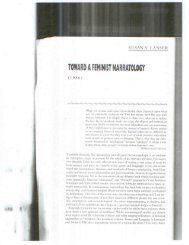Archetypal Characters Within the 'Slasher' Film Sub-Genre
Archetypal Characters Within the 'Slasher' Film Sub-Genre
Archetypal Characters Within the 'Slasher' Film Sub-Genre
You also want an ePaper? Increase the reach of your titles
YUMPU automatically turns print PDFs into web optimized ePapers that Google loves.
ENGL 1101<br />
Instructor: Ms. Julia Elliott<br />
(This essay analyzes articles from The Presence of O<strong>the</strong>rs.)<br />
<strong>Archetypal</strong> <strong>Characters</strong> <strong>Within</strong> <strong>the</strong> “Slasher” <strong>Film</strong> <strong>Sub</strong>-<strong>Genre</strong><br />
by Jonathan King<br />
One of <strong>the</strong> most telling traits of a society is how it entertains itself. Although Americans<br />
of <strong>the</strong> late twentieth century have many choices for distraction, one medium has had a<br />
particularly significant impact upon <strong>the</strong> fabric of American culture: film. Through pandering to<br />
<strong>the</strong> ideas and beliefs of <strong>the</strong> audience, filmmakers parallel those ideas and beliefs in <strong>the</strong>ir<br />
creations. This correlation was demonstrated in <strong>the</strong> glut of so-called “slasher” films during <strong>the</strong><br />
period 1974-1984. Although <strong>the</strong> films were diverse in form and execution, <strong>the</strong> basic plot of<br />
<strong>the</strong>se movies involved some sort of deranged psychopath gleefully stalking and killing a number<br />
of unfortunate teenage victims. <strong>Within</strong> this sub-genre <strong>the</strong>re can be found a number of basic<br />
character styles, or archetypes. These archetypes not only serve to bind certain movies into <strong>the</strong><br />
slasher category, but also to provide a window into <strong>the</strong> culture that <strong>the</strong>y cater to.<br />
In order to present a specific example of each archetype, I have chosen four films that are<br />
exemplary of <strong>the</strong> overall sub-genre. Tobe Hooper’s The Texas Chainsaw Massacre (1974) tells<br />
<strong>the</strong> story of a van full of traveling teenagers and <strong>the</strong>ir run-in with a family of backwoods<br />
cannibals. John Carpenter’s Halloween (1978) has killer Michael Myers strangling baby-sitters<br />
on <strong>the</strong> night of said movie title. Sean Cunningham’s Friday <strong>the</strong> 13 th (1980) looses a hockeymasked<br />
psychopath upon a host of unsuspecting camp counselors. Finally, Tobe Hooper’s The<br />
Funhouse (1981) finds four teens trapped in a carnival with a murderous sideshow freak.<br />
The most evident archetype within <strong>the</strong> slasher sub-genre is <strong>the</strong> Virgin. Usually <strong>the</strong> Virgin<br />
is <strong>the</strong> protagonist of <strong>the</strong> film, a female teenager of moral purity and physical desirability.<br />
Massacre’s Robin, Halloween’s Nancy, Friday’s Jane, and Funhouse’s Cynthia all fit this<br />
description. The Virgin, as her title implies, is depicted as a non-sexual being, devoid of any<br />
erotic thoughts or actions during <strong>the</strong> film. Although <strong>the</strong> trait is usually only implied, both<br />
Halloween and Funhouse’s protagonists are explicitly stated to be actual virgins. This asexuality<br />
is a symptom of <strong>the</strong> overall noble behavior that <strong>the</strong> Virgin characters share. Massacre’s Robin is<br />
constantly fretting and fussing over her handicapped bro<strong>the</strong>r, and Halloween’s Nancy<br />
relinquishes an anticipated date to baby-sit for family friends. Being <strong>the</strong> central character, <strong>the</strong><br />
Virgin must eventually do battle with <strong>the</strong> antagonist slasher. After a failed attempt to escape <strong>the</strong><br />
slasher, <strong>the</strong> Virgin usually turns to <strong>the</strong> offensive, as when Friday’s Jane dispatches <strong>the</strong> killer<br />
with a well-placed machete swipe. Essentially, <strong>the</strong> Virgin will seek a passive release from her<br />
situation, but will resort to violence if necessary.<br />
In contrast to <strong>the</strong> immaculate, angelic Virgin is <strong>the</strong> Slasher, a deranged murderer who<br />
will stop at nothing to end <strong>the</strong> lives of <strong>the</strong> generic band of teens he encounters. This generally<br />
male archetype has a penchant for wearing something to cover his face, be it a hockey mask in<br />
Friday, or a Frankenstein face in Funhouse. The Slasher also almost never uses intelligible<br />
speech. The Slashers in Massacre and Funhouse only communicate in primate-like grunts, while<br />
those in Halloween and Friday choose not to make a sound, remaining ominously silent. Despite<br />
<strong>the</strong> Slasher’s complete insanity, <strong>the</strong>se killers usually have a fairly rational motive for <strong>the</strong>ir<br />
nefarious deeds. Vengeance is a common motive, as when counselor neglect led to <strong>the</strong> apparent
drowning of Friday’s villain. O<strong>the</strong>r, more practical motives for murder can be found, as in<br />
Massacre’s killing for dietary needs, or Funhouse’s need to cover up a previous murder.<br />
Although not as necessary to <strong>the</strong> slasher film as <strong>the</strong> Virgin or <strong>the</strong> Slasher, <strong>the</strong> Doomsayer<br />
is ano<strong>the</strong>r elementary archetype within <strong>the</strong> sub-genre. This character is usually portrayed as a<br />
older person, disheveled and harmlessly eccentric. The Doomsayer arrives in <strong>the</strong> first half of <strong>the</strong><br />
film to predict danger for <strong>the</strong> main characters. The Doomsayer’s warnings are generally taken as<br />
insane ramblings, although <strong>the</strong>y almost always come true. For <strong>the</strong> most part, however, <strong>the</strong><br />
Doomsayer’s predictions are due to a disoriented mind, not to concrete evidence of <strong>the</strong> Slasher’s<br />
presence. When Friday’s Old Man Connor exhorts “Doomed are <strong>the</strong> lot of you! This camp is<br />
cursed!”, he unwittingly foreshadows <strong>the</strong> deaths of most of <strong>the</strong> skeptical counselors.<br />
The acceptance and frequent use of an archetype like <strong>the</strong> Virgin has much to say<br />
concerning <strong>the</strong> morality of contemporary society. While <strong>the</strong> Virgin is morally pure in thought<br />
and action, <strong>the</strong> remainder of <strong>the</strong> teenaged cast is quite <strong>the</strong> opposite, frequently engaging in<br />
premarital sex and drug use. One teenager in Funhouse even uses <strong>the</strong> death of a cashier to steal<br />
<strong>the</strong> contents of <strong>the</strong> till. Interestingly, <strong>the</strong> immoral supporting characters are systematically<br />
slaughtered while <strong>the</strong> Virgin lives to remain virtuous for ano<strong>the</strong>r day. What this turn of events<br />
implies is that sin equals death. If a person is involved in premarital sex, illegal drugs, or any<br />
o<strong>the</strong>r social wrong, that person will eventually meet an unfortunate and miserable end. In<br />
contrast, those who live a good life, according to cultural norms, will be rewarded with survival.<br />
Since <strong>the</strong> Virgin is <strong>the</strong> ultimate representation of good within <strong>the</strong> slasher film, <strong>the</strong><br />
representative of evil must be <strong>the</strong> Slasher. What is most intriguing abut this archetype is how<br />
inhuman <strong>the</strong> character always seems. The Slasher almost never uses <strong>the</strong> markedly human trait of<br />
speech, and any human features <strong>the</strong> villain might have are usually covered by a mask. If <strong>the</strong><br />
“good” Virgin is portrayed as a human, <strong>the</strong>n why is <strong>the</strong> “evil” slasher not? What does this<br />
relationship say about <strong>the</strong> culture’s beliefs concerning good and evil? Like <strong>the</strong> Virgin, man is<br />
inherently good and pure, despite <strong>the</strong> occasional slip-up or mistake. Evil, like <strong>the</strong> slasher,<br />
appears to be an inhuman, external force that is constantly endeavoring to bring ruin to <strong>the</strong><br />
righteous works of man. Essentially, <strong>the</strong> relationship between <strong>the</strong> Virgin and <strong>the</strong> Slasher is<br />
identical in <strong>the</strong> eyes of society to <strong>the</strong> relationship between man and evil, with right always<br />
triumphant in <strong>the</strong> end.<br />
The presence of <strong>the</strong> Doomsayer in slasher films parallels <strong>the</strong> existence of <strong>the</strong> many<br />
“gloom and doom”-spouting paranoiacs that populate society. From journals dedicated to<br />
conspiracy <strong>the</strong>ory to <strong>the</strong> crazed homeless who scream, “The end is near,” people everywhere see<br />
great danger in <strong>the</strong> future. While <strong>the</strong> doomsayer in real life is generally wrong, <strong>the</strong> Doomsayer<br />
archetype is almost always correct in his predictions. Does society want to believe in <strong>the</strong><br />
doomsayer in reality like it can in a slasher film? Quite possibly. Man has always wanted to<br />
believe <strong>the</strong> outlandish, from UFO’s to proof of leprechauns. The accuracy of <strong>the</strong> archetypal<br />
Doomsayer creates a world where man can believe in <strong>the</strong> strange and terrible, and be correct<br />
about it.<br />
While <strong>the</strong> primary heyday of <strong>the</strong> slasher film ended many years ago, America is in <strong>the</strong><br />
midst of a fresh trend of <strong>the</strong> sub-genre that began with <strong>the</strong> Wes Craven’s Scream (1994). These<br />
films are not only helping to carry <strong>the</strong> archetypes of Halloween and Friday <strong>the</strong> 13 th to a new<br />
generation of moviegoers, but also updating <strong>the</strong>m as <strong>the</strong> culture has updated itself. Despite <strong>the</strong><br />
changes some form of <strong>the</strong>se archetypes will continue to exist, no matter how much American<br />
society alters. As long as a teenager yearns for <strong>the</strong> adrenaline rush from a masked murder,<br />
slasher films and <strong>the</strong>ir archetypes will endure.
Works Cited<br />
Halloween. Dir. John Carpenter, with Donald Pleasence and Jamie Lee Curtis. Falcon<br />
Productions, 1978.<br />
Friday <strong>the</strong> 13 th . Dir. Sean Cunningham. Paramount, 1980.<br />
The Funhouse. Dir Tobe Hooper. Universal, 1981.<br />
McCarthy, Ken. The Splatter <strong>Film</strong> Guide. New York: St. Martin’s Press, 1992.<br />
The Texas Chainsaw Massacre. Dir Tobe Hooper. Rosebud Communications, 1974.



